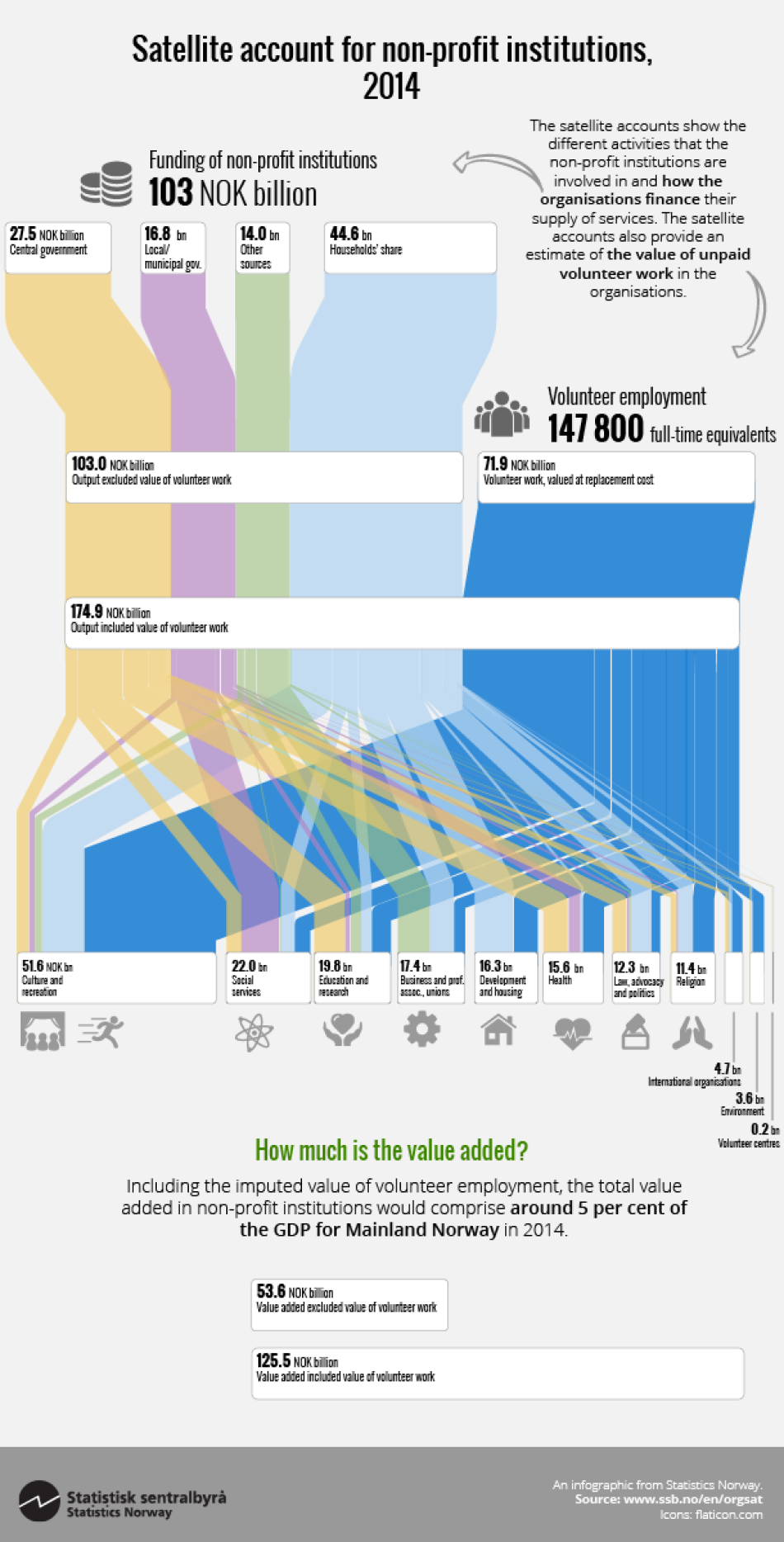Volunteer work reaches nearly 148 000 full-time equivalents
Published:
Not counting volunteer work, non-profit institutions are estimated to have contributed NOK 53 billion, or 1.7 per cent, to the gross domestic product (GDP).
- Full set of figures
- Satellite account for non-profit institutions
- Series archive
- Satellite account for non-profit institutions (archive)
Including the value of unpaid work, the total value added in the non-profit sector accounted for around NOK 125.5 billion, or 3.9 per cent of the GDP in 2014.
There were just over 86 100 paid FTEs in the sector as a whole; an increase of 2.2 per cent from the year before. A study on volunteer work by the Institute for Social Research indicates that there were just over 1.7 unpaid FTEs for every paid FTE. In addition to the volunteer effort, contributions from households covered more than 43 per cent of the organisations´ total operating costs in 2014.
Health, social services and education contribute most to value added
Non-profit institutions are involved in a wide array of activities, performing important tasks in the Norwegian welfare society. It was mainly the same activities that contributed the most to total value added in 2014 as in previous years. Health and social services, along with education and research, contributed almost 58 per cent of the value added in the non-profit sector, not including volunteer work. Institutions within the area of culture and recreation contributed just over 13 per cent, while institutions within other activities contributed approximately 29 per cent in total.
Culture and recreation area has greatest voluntary effort
The amount of volunteer work varies greatly between institutions within the different activities. The area with the greatest amount of volunteer work is by far culture and recreation, including sports, where almost half of the unpaid FTEs are found. The contribution to the total value added from this category rises to almost 34 per cent when the value of volunteer effort is included. The volunteer effort in sports alone constituted just over 34 300 unpaid FTEs, or around 23 per cent of the total unpaid FTEs.
Income from households covers almost 44 per cent of the organisations´ operating income
Non-profit institutions finance their activities through several different channels, from sales of services to public and private participants, government transfers, membership payments, sponsors, gifts, collections and more. The calculations in this satellite account are intended to show how the organisations finance their operations. Funds for investment purposes or activities abroad are therefore excluded from this framework.
Calculations of the non-profit institutions´ sources of income show that, in addition to the considerable amount of unpaid volunteer work, income from households cover more than 43 per cent of the organisations´ total operating costs. Central and local government contributed around 27 and 16 per cent of the operating costs through transfers and purchase of services, while the remaining 14 per cent was funded by the corporate sector.
Of the funding from central and local government, almost 73 per cent went to institutions supplying welfare services such as health and social services, education and research. The funds from the central government are mainly directed towards health and education, while the funding from local government mostly targets social services and nursing homes. Approximately 11 per cent of the public transfers went to culture and recreational activities. Organisations within culture and recreation obtain most of their income from households, around 62 per cent. Of the total transfers from households, nearly NOK 11 billion, or 24 per cent, went to culture and recreation. The funding from the corporate sector was mainly targeted towards business and professional associations, in addition to education and research.

Contact
-
Thom Åbyholm
-
Statistics Norway's Information Centre
